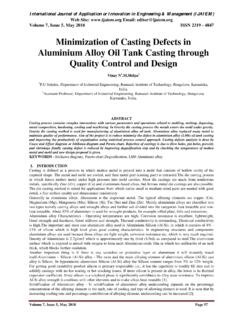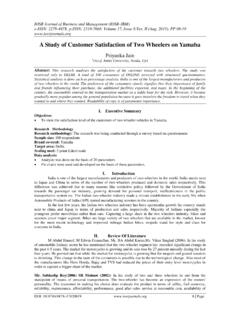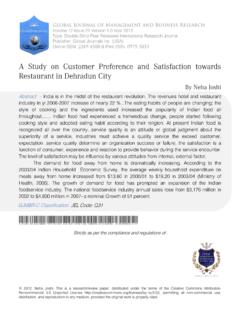Transcription of PERCEPTION AND AWARENESS OF CUSTOMER TOWARDS …
1 International Journal of Application or Innovation in Engineering & Management (IJAIEM). Web Site: Email: Volume 7, Issue 3, March 2018 ISSN 2319 - 4847. PERCEPTION AND AWARENESS OF. CUSTOMER TOWARDS CASHLESS. TRANSACTION; A CASE study . Dr. Rajanna Associate Professor and Co-ordintor Dept. of Studies in Economics Govt. College, Chikkamagaluru, Karnataka, - 577102. Abstract The empirical studies about PERCEPTION and AWARENESS of customers TOWARDS cashless transactions. Review of relevant literatures reveals lack of AWARENESS and lack of literacy regarding cashless transaction. In this study , results showed that AWARENESS , digital literacy, proper infrastructure and rate of participation of the customers in cashless transaction were found to have strong significant relation with cash less transaction.
2 The objective of the study is to find the response TOWARDS cashless economy in Chikmagaluru district of Karnataka. The samples were selected in simple random sampling method. Primary data was collected using questionnaire from the 150 respondents. The primary data was analysed using simple statistical tools like percentage method. Further the study reveals that majority of them are aware and agree that cashless transactions will help to fight against corruption black money and reduce the risk of carrying cash and can also faster economic growth. Based on the findingsome recommendations made are the government should adopt a different strategy of educations non-literate people about the cashless economy. Key words: Cashless Economy, Black Money, Digital Literacy, CUSTOMER PERCEPTION , Faster Economic Growth INTRODUCTION.
3 A cashless economy is a situation in which the financial transactions are made by digital currencies. Cash less economy means the cashless transaction. In India, too much of transactions are made through cash. Less than 5 percent of total payments happen through electronically. Illiterate people do not know how to use digital transactions. Financial literacy and AWARENESS about cash less transactions is paramount in India to make the cashless economy. Nearly 26% of India has internet access, and there are only 200 million users of digital payment services. Banks and financial institutions offering discounts on purchase with credit/ debit cards and online wallets offering attractive deals for payments have made Indians comfortable with paperless transactions.
4 LITERATURE REVIEW. The review of literature paves way for clear understanding of the area of research already undertaken and throws a light potential areas which are yet to be covered. In this regard an attempt has been made to make a brief survey of the work under-taken on the field of cash less transactions. To review some of the important studies are presented below such as. Sedhirkumarsharma, Vandanalama and NidheGoyal (2015)In their study digital India concept is motive to build participative transparent and responsive system and provide all services to people to electronically and promote digital knowledge. Piyuth Kumar (2015)Reveals that in his study to assess the behaviour TOWARDS cashless transactions system and how for they are adopted to this new world of cashless society.
5 SushanaPatil (2014)In their study customers have showed their preference over the usage of plastic money generally over a period of time in the banking process. Various types of plastic cards provided by banks in India are ATM cards, smart cards etc. Moses Ashike (2011) the functioning of the cashless economy are enhanced by e-finance, e-money, These all refers to how transactions and payments are effected in a cashless economy. Roth (2010) Reveals that in his study to a have extent are moving away from paper payment instruments toward electronic ones, especially payment cards, Jain (2006)In this study cashless transaction system taking fullest advantage of technology, quick payments and remittance will ensure optimal use of available funds for banks, financial institutions and common people of India.
6 Further focus on the need for e payment and modes of e- payments and communication networks. Volume 7, Issue 3, March 2018 Page 33. International Journal of Application or Innovation in Engineering & Management (IJAIEM). Web Site: Email: Volume 7, Issue 3, March 2018 ISSN 2319 - 4847. IMPORTANCE OF THE study . The cashless transaction is one of the most important concepts in now a days, Prospects for Cashless Economy in India. The Indian economy countries to be driven by the use of cash less than 5% of all payments happen electronically. In India the ratio of cash to gross domestic products in GDP, this is one of the highest in the world. It was in china and 4% in main advantages of PERCEPTION of cashless society is that a record of all economic transactions through electronic means makes it almost possible to sustain black market or underground economics that often prove damaging to national economics.
7 According to Info Wars,Cashless transaction is having so much importance like digital economy will help to enhance our current banking system. Increase the tax net boost in consumption security and convenience etc. The PERCEPTION of CUSTOMER on cashless transaction the advantages to citizens of a county in a cashless economy are, risk of carrying notes and loss of hard earned money can be avoided. Transaction costs are likely to be reducing. Convenience in shopping, payment of bills and scheduling of finical transactions managed from home, office or wherever with a smart phone, reduces expenditure in reducing need for printing of currency notes and its transportation reducing the black money and corruption, etc. This study also helps to the society the purpose of people understanding the positive and negative effect of cashless transaction and which are factors are affecting on the cashless transaction.
8 RESEARCH METHODOLOGY. This research study is mainly based on the survey research. Simple random and multi stage stratified random sampling technique has used. It is based on well-structured questionnaire which was conducted to study the AWARENESS and perceptions of customers TOWARDS cashless transactions. Thequestionnaire were distributed to 150 respondents in different occupation and different banks in Chikkmagalurudistrict of the Karnataka, Chikkamagalurudistrict has a strong banking network in all the taluks. The data were collected by using a well-structured questionnaire which contains socio economic characteristics of the respondents methods benefits and problems of cash-less transactions. Primary data were collected with the help of questionnaire from 150 respondents of the Chikmagalurudistrict.
9 Secondary data were collected with the help of online sources, journals and reports. Data analysis is based on the simple statistical tools and techniques such as average percentage etc. for explaining the results regarding the PERCEPTION and AWARENESS TOWARDS cash-less transactions. DATA ANALYSIS AND INTERPRETATION. Table No-01. Socio-Economic Profit of Respondent (in-150). Sl. no Particulars No. Respondents Percentage 01 Age 18-30 69 46. 31-40 54 36. 41-50 24 16. 51-60 03 02. Above 60 all 150 100. 02 Gender Male 108 72. Female 42 28. All 150 100. 03 Education Primary 18 12. Secondary 33 22. Higher education 99 66. All 150 100. 04 Marital Status Married 54 36. Un married 96 64. All 150 100. 05 Occupation Agriculturist 12 9.
10 Business 63 42. Labour 08 Employees 52 Volume 7, Issue 3, March 2018 Page 34. International Journal of Application or Innovation in Engineering & Management (IJAIEM). Web Site: Email: Volume 7, Issue 3, March 2018 ISSN 2319 - 4847. All 150 06 Household Monthly Income (Rs). Less than Rs 25,000 10 Rs. 25001-50,000 20 Rs. 50001-75,000 55 Rs. 75001-1,00,000 43 Rs. Above 1,00,001 22 All 150 Source: Field survey. Socio-economic conditions of customers such as Gender, age, Marital status,education, household monthly income and occupation have been made significant influence on the PERCEPTION and AWARENESS of cashless transactions (economy) in the economy. The table No. 01 provides the data on socio-economic conditions of the sample respondents.















